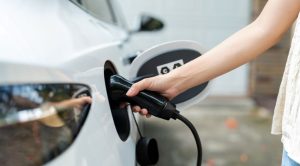
Electric vehicles (EVs) have gained significant popularity over the last decade and are part of the collective solution toward a cleaner energy future. Yet, some drivers still have questions about their cost, emissions, and safety, among other things.
I spoke with Moaz Uddin, our senior EV policy specialist for Transportation and Fuels, to help address these questions and explore some of GPI’s research.
Let’s start with the cost. Are EVs cheaper to own over time than gas-powered cars? What goes into that cost?
With vehicle ownership, whether you look at an EV as a fleet vehicle or a personal vehicle, the upfront cost can sometimes cause sticker shock. While it’s true that EVs are more expensive up front right now, they save money in the long run.
EVs have an advantage—their lifetime cost is much lower due to operational costs. EVs cut maintenance costs in half compared to a gas-powered car, and driving an EV can save up to $1,500 annually on fuel. Overall, EVs typically have around 20 to 25 moving parts, while conventional vehicles can have up to 2,000. This mechanical simplicity means EVs can potentially last longer since fewer things can break, and it definitely means fewer trips to an automotive shop (no oil changes!).
The upfront cost can also be lowered. Currently, the federal government offers a tax credit of up to $7,500 to purchase qualified new or used EVs. On top of that, many states and electric utilities offer additional rebates, making EVs more affordable for more people. Leasing is another great option, and just at the end of last year, the average EV lease payment was $175 less than an auto loan payment.
Do EV batteries need any maintenance?
No, replacing batteries is not part of the maintenance schedule, and that’s something that most EV drivers don’t deal with. Unlike the small lead-acid batteries we have on our gas vehicles, which have to be replaced every five years, lithium-ion batteries that go into EVs last much longer. They are designed to last up to 20 years, and we are still learning about their full potential because EVs have not been around for that long compared to gas cars.
Of course, there will be exceptions, just like with any vehicle. Still, if anything goes wrong within the warranty period, which is typically 8 to 10 years, the dealer will replace the damaged part, including the battery.
How do EVs compare with gas vehicles in terms of emissions?
EVs outperform conventional vehicles in terms of total lifecycle emissions. We just published a study that compares the lifecycle emissions of EVs and conventional vehicles on a one-on-one basis for five different categories of vehicles.
We found that even with EVs produced and charged using today’s grid, which is far from clean, EVs have much lower emissions over the vehicle’s lifetime compared to their conventional counterparts.
For example, and we show this in the study, an electric Ford F-150 Lightning produces 44 percent fewer carbon dioxide (CO2) emissions than the popular gas F-150 over its lifetime.
In a scenario where an EV is produced on a clean grid with its battery made from 20 percent recycled materials, the emissions can be reduced by up to 90 percent over its lifetime. This difference is significant.
What is the reality of how far most people need to go, and what is the available charging infrastructure?
The average American driver’s commute is about 30 miles, while the average range of EVs is about 270 miles. Some EVs can even go up to 500 miles.
Most EV charging happens at home and often overnight, just like our cellphones, so the EV is fully charged and ready to go every morning. While it’s true that the public EV charging network is not as extensive as the gasoline fueling network, most drivers underestimate how many fast chargers there are along their travel routes for longer trips and in their communities.
In the last few years, the federal government has invested in transportation electrification infrastructure through the National Electric Vehicle Infrastructure (NEVI) Formula Program and the Charging and Fueling Infrastructure Grant Program. These programs aim to eliminate range anxiety by placing high-powered chargers every 50 miles along major freeways and highways. While, unfortunately, these programs are currently paused, significant progress has already been made across the country.
Depending on the location, EV drivers may still need to do a little bit of planning in advance for longer road trips. However, most new EVs now have software that locates the next charging station and will precondition the battery so that when you arrive, all it takes is 15 to 20 minutes to get back on the road with a full charge.
How does EV safety compare to conventional vehicle safety?
There are several instances I can think of when I would feel safer driving an EV rather than a gas-powered car. Despite the media’s focus on rare incidents, EVs in the US are 60 times less likely to catch fire than gas-powered vehicles. This is due to EVs being equipped to help prevent fires caused by overcharging. They also alert drivers about any potential issues or risks before a critical mechanical failure.
EV fires are also different—EVs don’t explode like cars do in the movies. In the rare instance an EV does catch on fire, it typically starts in a single battery cell before slowly spreading to other cells. This gives drivers more time to safely exit the vehicle since there are no materials to combust, unlike conventional vehicles. Because of the unique nature of EV fires, firefighters across the US have been learning how to put those out effectively.
Having lived in Minnesota, I know winter driving can be challenging. EVs can perform as well or even better than gas cars when it comes to traction and winter handling. EVs can be more stable due to advanced traction control, all-wheel drive options, and the weight distribution from battery packs. Plus, drivers can always switch to winter tires for even better traction and handling.
When it comes to extremely cold winter temperatures, all vehicles lose efficiency. EVs can and do function in cold climates, and heat pumps and other continuous technological advancements are minimizing the power draw on batteries, improving EV efficiency in the winter months.
EVs also don’t have tailpipe emissions and can be safely operated in closed garages without the risk of inhaling carbon monoxide, which can be deadly in high concentrations. The hidden benefit is that you can preheat your EV’s cabin in the colder months without ever opening your garage. Additionally, anytime an EV is idling, like in traffic jams or at stoplights, it doesn’t produce any emissions, making the air cleaner and safer for fellow pedestrians and drivers.
Any last thoughts?
While there’s still room for improvement, EVs are here to stay and offer many benefits over gas-powered cars. They suit most drivers’ needs and are part of the solution to reduce greenhouse gas emissions for the transportation sector. They are available at many price points, function in different climates, and save money and time for drivers.
Read more from Moaz on the EV policy landscape in Minnesota in this recent MPR News story. Stay up to date with our EV work by signing up for our newsletter. If you’re interested in our EV work in Minnesota, check out the GPI-facilitated Drive Electric Minnesota coalition.


